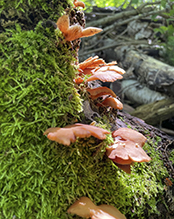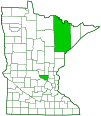fungus
(Scytinotus longinquus)
Conservation • Description • Habitat • Ecology • Distribution • Taxonomy
Conservation Status |
|
|||||||
| IUCN Red List | not listed |
|||||||
| NatureServe | not listed |
|||||||
| Minnesota | not listed |
|||||||
Description |
||
Scytinotus longinquus is a small, gilled mushroom. It occurs in North America, Chile, Argentina, eastern Australia, and New Zealand. It is found usually in groups or overlapping clusters, sometimes alone. In the Pacific Northwest it grows mostly on partially or completely debarked fallen logs and branches of red alder, rarely also on conifers, including western hemlock stumps. It obtains its nutrients from decayed wood (saprobic). When it first appears, the cap is orb-shaped, pale ivory, orangish-white, tan, or pale orange, and the margins are rolled inward. As it ages it expands and the color changes. The mature cap is fan-shaped, kidney-shaped, or irregularly lobed, 1⁄16″ to 1½″ (2 to 10 mm) wide, and 1⁄32″ to ¾″ (1 to 20 mm) long. It is convex when viewed from the side but depressed near the base. It may be pinkish or brownish-orange to light brown. The upper surface is hairless, opaque, and concentrically wrinkled. When wet it is often slimy or sticky and more or less transparent (hygrophanous). Older specimens are brown with purplish-brown or grayish-brown areas. The gills are 1⁄32″to ⅛″ (1 to 3 mm) broad and pale yellowish-white or colored like the cap. When a stalk or pseudostalk is present, the gills slightly run down it. They are closely spaced when young, somewhat more widely spaced when mature. There are 16 to 36 gills per ⅜″ (1 cm) at the margin, 14 to 35 gills per ⅜″ (1 cm) at the stalk. The edges of the gills are not gelatinous. There may be a well-developed stalk, a stalk-like prolongation of the cap (pseudostalk), or no stalk at all. When present, the stalk is firm, attached at the side of the cap (lateral), horizontal to ascending, 1⁄32″ to ⅜″ (1 to 9 mm) long, and 1⁄32″ to 3⁄16″ (1 to 5 mm) wide. It is solid and white when young, becoming hollow and ivory, yellowish, peach, or brown with age. There are usually some coarse white hairs toward the base. The flesh is thin, firm, fibrous, and white to pale pinkish-tan. Its edibility is unknown and the taste is not distinctive. The spore print is dingy yellowish-cream. |
||
Similar Species |
||
Habitat and Hosts |
||
|
||
Ecology |
||
Season |
||
|
||
Distribution |
||||
|
Sources Until very recently, this species was known in North America only in the Pacific Northwest. iNaturalist has several dozen citizen observations beginning in 2020 in the eastern United States, including one 2020 observation from Sherburne County in Minnesota. No other source, including GBIF, Encyclopedia of Life, NatureServe, MycoPortal, and Mushroom Observer, has any records east of the Rocky Mountains. |
|||
| 2/5/2023 | ||||
Occurrence |
||||
|
||||
Taxonomy |
|||
| Kingdom | Fungi (fungi) | ||
| Subkingdom | Dikarya | ||
| Phylum | Basidiomycota (club fungi) | ||
| Subphylum | Agaricomycotina (jelly fungi, yeasts, and mushrooms) | ||
| Class | Agaricomycetes (mushrooms, bracket fungi, puffballs, and allies) | ||
| Subclass | Agaricomycetidae | ||
| Order | Agaricales (common gilled mushrooms and allies) | ||
| Suborder | Marasmiineae | ||
Family |
Porotheleaceae | ||
Genus |
Scytinotus | ||
A recently published morphological and molecular DNA analysis of the genus Panellus and related species (Jin, et al., 2001) recommended moving several Panellus species to other genera. Panellus longinquus was moved to the genus Pleurotopsis. In 2012 it was moved to the genus Scytinotus, but the move was not universally adopted. MycoBank uses the name Scytinotus longinquus, Index Fungorum uses the name Panellus longinquus. |
|||
Synonyms |
|||
Agaricus longinquus Dendrosarcus longinquus Panellus longinquus Pleurotus longinquus Pleurotopsis longinqua |
|||
Common Names |
|||
This species has no common name. |
|||
Glossary
Hygrophanous
Referring to mushroom tissue that is dark and more or less transparent when moist, becoming paler and opaque as it dries out.
Saprobic
A term often used for saprotrophic fungi. Referring to fungi that obtain their nutrients from decayed organic matter.
Visitor Photos |
|||||
Share your photo of this fungus. |
|||||
| This button not working for you? Simply email us at info@MinnesotaSeasons.com. Attach one or more photos and, if you like, a caption. |
|||||
Honey Fae (Farah) |
|||||
 |
|||||
MinnesotaSeasons.com Photos |
|||||
|
|||||

Slideshows |
||

Visitor Videos |
|||
Share your video of this fungus. |
|||
| This button not working for you? Simply email us at info@MinnesotaSeasons.com. Attach a video, a YouTube link, or a cloud storage link. |
|||
Other Videos |
|||
| Most Beautiful Mushroom | Rosy Oysterling (Scytinotus longinquus) Earth Titan |
|||
About
Feb 10, 2022 |
|||
| Scytinotus Longinquus Wild NatureLover🦩 |
|||
About
Oct 9, 2022 The Scytinotus longinquus can be found in wet forests. It forms its fruitbody on deadwood, usually on mossy logs and stumps. |
|||
| Wild Pink Oyster in Canada? Grow Mushrooms Canada |
|||
About
Jan 6, 2023 A stunning display of Panellus longinquus, fruiting from red alder New Year's day 2023 down the road from our mushroom farm in Sayward BC. Although they look like a pink oyster mushroom, with gills radiating like a fan on the underside of a deep pink cap - their edibility is unknown. Some mushrooms are deadly poisonous, so never eat a wild mushroom without being 100% sure of it's identification. Delicious edible oyster mushrooms are very easy to grow from a kit we sell! Happy New Year and Mush Abundance from our team at Grow Mushrooms Canada. |
|||

Created: 2/5/2023
Last Updated:


